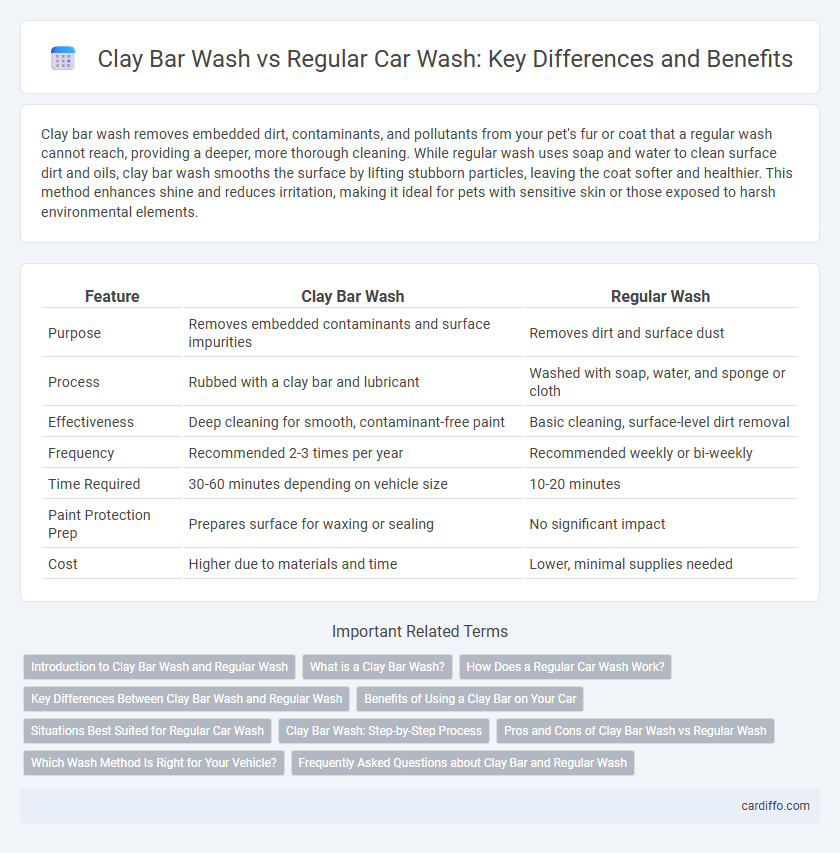Clay bar wash removes embedded dirt, contaminants, and pollutants from your pet's fur or coat that a regular wash cannot reach, providing a deeper, more thorough cleaning. While regular wash uses soap and water to clean surface dirt and oils, clay bar wash smooths the surface by lifting stubborn particles, leaving the coat softer and healthier. This method enhances shine and reduces irritation, making it ideal for pets with sensitive skin or those exposed to harsh environmental elements.
Table of Comparison
| Feature | Clay Bar Wash | Regular Wash |
|---|---|---|
| Purpose | Removes embedded contaminants and surface impurities | Removes dirt and surface dust |
| Process | Rubbed with a clay bar and lubricant | Washed with soap, water, and sponge or cloth |
| Effectiveness | Deep cleaning for smooth, contaminant-free paint | Basic cleaning, surface-level dirt removal |
| Frequency | Recommended 2-3 times per year | Recommended weekly or bi-weekly |
| Time Required | 30-60 minutes depending on vehicle size | 10-20 minutes |
| Paint Protection Prep | Prepares surface for waxing or sealing | No significant impact |
| Cost | Higher due to materials and time | Lower, minimal supplies needed |
Introduction to Clay Bar Wash and Regular Wash
Clay bar wash uses a soft clay compound to remove embedded contaminants like tar, brake dust, and industrial fallout from the vehicle's paint surface, providing a deeper clean than regular washing. Regular wash typically involves soap, water, and a sponge or mitt to remove dirt, dust, and grime but does not eliminate bonded particles. Clay bar treatment enhances paint smoothness and prepares the surface for polishing and waxing, while regular washing primarily maintains basic cleanliness.
What is a Clay Bar Wash?
A clay bar wash involves using a specialized clay bar to remove embedded contaminants from the car's paint surface that regular washing cannot eliminate, such as industrial fallout, brake dust, and overspray. This process enhances paint smoothness and prepares the vehicle for waxing or sealing by providing a cleaner, contamination-free surface. Unlike a regular wash, which primarily cleans dirt and grime, a clay bar wash offers deeper decontamination for improved paint protection and finish quality.
How Does a Regular Car Wash Work?
A regular car wash typically uses high-pressure water jets and detergents to remove surface dirt, grime, and loose contaminants from the vehicle's exterior. Automated systems often include rotating brushes or cloth strips that scrub the surface, followed by a rinse cycle to eliminate soap residue. This method effectively cleans but may not remove embedded contaminants or oxidation like a clay bar treatment can.
Key Differences Between Clay Bar Wash and Regular Wash
Clay bar wash removes bonded contaminants like tar, sap, and industrial fallout that regular washing cannot eliminate, providing a deeper clean. Regular wash primarily targets surface dirt and grime using soap and water without addressing embedded particles. This makes clay bar treatment essential before waxing to ensure a smooth, contaminant-free surface for better product adhesion.
Benefits of Using a Clay Bar on Your Car
Using a clay bar on your car removes embedded contaminants like brake dust, tar, and industrial fallout that traditional washing cannot eliminate. This process restores the smoothness of the paint surface, enhancing the effectiveness of wax or sealant application. Regular use of a clay bar promotes a cleaner, shinier finish that extends the lifespan of your vehicle's paint.
Situations Best Suited for Regular Car Wash
Regular car wash is best suited for routine maintenance when the vehicle has light dirt, dust, or pollen buildup that does not require extensive clay bar treatment. It effectively removes surface contaminants without the risk of paint abrasion or the time commitment associated with clay bar wash. Ideal for weekly or bi-weekly cleaning to preserve paint clarity and protect the clear coat finish in everyday driving conditions.
Clay Bar Wash: Step-by-Step Process
Clay bar wash involves using a specialized clay bar to remove embedded contaminants from the vehicle's paint surface, such as industrial fallout, tree sap, and brake dust, which regular washing cannot eliminate. The process begins by thoroughly washing the car to remove loose dirt, followed by lubricating a small section of the paint with a clay lubricant or detailing spray to prevent scratching. The clay bar is then gently rubbed over the lubricated area, lifting contaminants, and the treated section is wiped clean before moving on to the next part, ensuring a smooth and clean surface ideal for waxing or sealing.
Pros and Cons of Clay Bar Wash vs Regular Wash
Clay bar wash removes embedded contaminants, such as industrial fallout, tree sap, and brake dust, providing a smoother and cleaner surface compared to a regular wash that primarily removes surface dirt and grime. The process can restore paint clarity and improve wax or sealant adhesion but is more time-consuming and requires careful technique to avoid paint marring. Regular wash is faster, simpler, and less costly but may leave bonded particles on the paint, potentially leading to swirl marks or dullness over time.
Which Wash Method Is Right for Your Vehicle?
Clay bar wash effectively removes embedded contaminants like tar, sap, and industrial fallout that regular washes often miss, restoring a smoother and cleaner surface. Regular washes primarily target surface dirt and grime, maintaining daily cleanliness but not addressing deeper impurities. Choosing between the two depends on your vehicle's condition and frequency of use; clay bar treatments are ideal for periodic deep cleaning, while regular washes suit routine maintenance.
Frequently Asked Questions about Clay Bar and Regular Wash
Clay bar wash effectively removes bonded contaminants like tar, tree sap, and industrial fallout that regular wash cannot eliminate. Regular wash primarily cleans surface dirt and grime using soap and water but may leave behind embedded particles, risking paint roughness. Frequently asked questions highlight clay bar safety, proper technique, and frequency compared to the convenience and speed of a standard wash.
Clay Bar Wash vs Regular Wash Infographic

 cardiffo.com
cardiffo.com